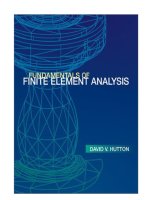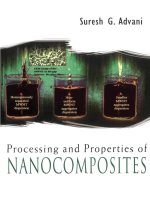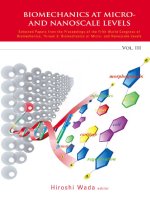- Trang chủ >>
- Khoa Học Tự Nhiên >>
- Vật lý
fundamentals of nanoscale film analysis, 2007, p.349
Bạn đang xem bản rút gọn của tài liệu. Xem và tải ngay bản đầy đủ của tài liệu tại đây (4.71 MB, 349 trang )
Fundamentals of Nanoscale
Film Analysis
Fundamentals of Nanoscale
Film Analysis
Terry L. Alford
Arizona State University
Tempe, AZ, USA
Leonard C. Feldman
Vanderbilt University
Nashville, TN, USA
James W. Mayer
Arizona State University
Tempe, AZ, USA
Terry L. Alford
Arizona State University
Tempe, AZ, USA
Leonard C. Feldman
Vanderbilt University
Nashville, TN, USA
James W. Mayer
Arizona State University
Tempe, AZ, USA
Fundamentals of Nanoscale Film Analysis
Library of Congress Control Number: 2005933265
ISBN 10: 0-387-29260-8
ISBN 13: 978-0-387-29260-1
ISBN 10: 0-387-29261-6 (e-book)
Printed on acid-free paper.
C
2007 Springer Science+Business Media, Inc.
All rights reserved. This work may not be translated or copied in whole or in part without the written
permission of the publisher (Springer Science+Business Media, Inc., 233 Spring Street, New York, NY 10013,
USA), except for brief excerpts in connection with reviews or scholarly analysis. Use in connection with
any form of information storage and retrieval, electronic adaptation, computer software, or by similar or
dissimilar methodology now known or hereafter developed is forbidden.
The use in this publication of trade names, trademarks, service marks and similar terms, even if they are
not identified as such, is not to be taken as an expression of opinion as to whether or not they are subject to
proprietary rights.
Printed in the United States of America.
987654321 SPIN 11502913
springer.com
To our wives and children,
Katherine and Dylan,
Betty, Greg, and Dana,
and
Betty, Jim, John, Frank, Helen, and Bill
Contents
Preface xiii
1. An Overview: Concepts, Units, and the Bohr Atom 1
1.1 Introduction 1
1.2 Nomenclature 2
1.3 Energies, Units, and Particles 6
1.4 Particle–Wave Duality and Lattice Spacing 8
1.5 The Bohr Model 9
Problems 10
2. Atomic Collisions and Backscattering Spectrometry 12
2.1 Introduction 12
2.2 Kinematics of Elastic Collisions 13
2.3 Rutherford Backscattering Spectrometry 16
2.4 Scattering Cross Section and Impact Parameter 17
2.5 Central Force Scattering 18
2.6 Scattering Cross Section: Two-Body 21
2.7 Deviations from Rutherford Scattering at Low and High Energy 23
2.8 Low-Energy Ion Scattering 24
2.9 Forward Recoil Spectrometry 28
2.10 Center of Mass to Laboratory Transformation 28
Problems 31
3. Energy Loss of Light Ions and Backscattering Depth Profiles 34
3.1 Introduction 34
3.2 General Picture of Energy Loss and Units of Energy Loss 34
3.3 Energy Loss of MeV Light Ions in Solids 35
3.4 Energy Loss in Compounds—Bragg’s Rule 40
3.5 The Energy Width in Backscattering 40
3.6 The Shape of the Backscattering Spectrum 43
3.7 Depth Profiles with Rutherford Scattering 45
3.8 Depth Resolution and Energy-Loss Straggling 47
viii Contents
3.9 Hydrogen and Deuterium Depth Profiles 50
3.10 Ranges of H and He Ions 52
3.11 Sputtering and Limits to Sensitivity 54
3.12 Summary of Scattering Relations 55
Problems 55
4. Sputter Depth Profiles and Secondary Ion Mass Spectroscopy 59
4.1 Introduction 59
4.2 Sputtering by Ion Bombardment—General Concepts 60
4.3 Nuclear Energy Loss 63
4.4 Sputtering Yield 67
4.5 Secondary Ion Mass Spectroscopy (SIMS) 69
4.6 Secondary Neutral Mass Spectroscopy (SNMS) 73
4.7 Preferential Sputtering and Depth Profiles 75
4.8 Interface Broadening and Ion Mixing 77
4.9 Thomas–Fermi Statistical Model of the Atom 80
Problems 81
5. Ion Channeling 84
5.1 Introduction 84
5.2 Channeling in Single Crystals 84
5.3 Lattice Location of Impurities in Crystals 88
5.4 Channeling Flux Distributions 89
5.5 Surface Interaction via a Two-Atom Model 92
5.6 The Surface Peak 95
5.7 Substrate Shadowing: Epitaxial Au on Ag(111) 97
5.8 Epitaxial Growth 99
5.9 Thin Film Analysis 101
Problems 103
6. Electron–Electron Interactions and the Depth Sensitivity of
Electron Spectroscopies 105
6.1 Introduction 105
6.2 Electron Spectroscopies: Energy Analysis 105
6.3 Escape Depth and Detected Volume 106
6.4 Inelastic Electron–Electron Collisions 109
6.5 Electron Impact Ionization Cross Section 110
6.6 Plasmons 111
6.7 The Electron Mean Free Path 113
6.8 Influence of Thin Film Morphology on Electron Attenuation 114
6.9 Range of Electrons in Solids 118
6.10 Electron Energy Loss Spectroscopy (EELS) 120
6.11 Bremsstrahlung 124
Problems 126
Contents ix
7. X-ray Diffraction 129
7.1 Introduction 129
7.2 Bragg’s Law in Real Space 130
7.3 Coefficient of Thermal Expansion Measurements 133
7.4 Texture Measurements in Polycrystalline Thin Films 135
7.5 Strain Measurements in Epitaxial Layers 137
7.6 Crystalline Structure 141
7.7 Allowed Reflections and Relative Intensities 143
Problems 149
8. Electron Diffraction 152
8.1 Introduction 152
8.2 Reciprocal Space 153
8.3 Laue Equations 157
8.4 Bragg’s Law 158
8.5 Ewald Sphere Synthesis 159
8.6 The Electron Microscope 160
8.7 Indexing Diffraction Patterns 166
Problems 172
9. Photon Absorption in Solids and EXAFS 174
9.1 Introduction 174
9.2 The Schr¨odinger Equation 174
9.3 Wave Functions 176
9.4 Quantum Numbers, Electron Configuration,
and Notation 179
9.5 Transition Probability 180
9.6 Photoelectric Effect—Square-Well Approximation 181
9.7 Photoelectric Transition Probability for
a Hydrogenic Atom 184
9.8 X-ray Absorption 185
9.9 Extended X-ray Absorption Fine Structure (EXAFS) 189
9.10 Time-Dependent Perturbation Theory 192
Problems 197
10. X-ray Photoelectron Spectroscopy 199
10.1 Introduction 199
10.2 Experimental Considerations 199
10.3 Kinetic Energy of Photoelectrons 203
10.4 Photoelectron Energy Spectrum 204
10.5 Binding Energy and Final-State Effects 206
10.6 Binding Energy Shifts—Chemical Shifts 208
10.7 Quantitative Analysis 210
Problems 211
x Contents
11. Radiative Transitions and the Electron Microprobe 214
11.1 Introduction 214
11.2 Nomenclature in X-Ray Spectroscopy 215
11.3 Dipole Selection Rules 215
11.4 Electron Microprobe 216
11.5 Transition Rate for Spontaneous Emission 220
11.6 Transition Rate for K
α
Emission in Ni 220
11.7 Electron Microprobe: Quantitative Analysis 222
11.8 Particle-Induced X-Ray Emission (PIXE) 226
11.9 Evaluation of the Transition Probability for Radiative Transitions 227
11.10 Calculation of the K
β
/K
α
Ratio 230
Problems 231
12. Nonradiative Transitions and Auger Electron Spectroscopy 234
12.1 Introduction 234
12.2 Auger Transitions 234
12.3 Yield of Auger Electrons and Fluorescence Yield 241
12.4 Atomic Level Width and Lifetimes 243
12.5 Auger Electron Spectroscopy 244
12.6 Quantitative Analysis 248
12.7 Auger Depth Profiles 249
Problems 252
13. Nuclear Techniques: Activation Analysis and Prompt Radiation Analysis 255
13.1 Introduction 255
13.2 Q Values and Kinetic Energies 259
13.3 Radioactive Decay 262
13.4 Radioactive Decay Law 265
13.5 Radionuclide Production 266
13.6 Activation Analysis 266
13.7 Prompt Radiation Analysis 267
Problems 274
14. Scanning Probe Microscopy 277
14.1 Introduction 277
14.2 Scanning Tunneling Microscopy 279
14.3 Atomic Force Microscopy 284
Appendix 1. K
M
for
4
He
+
as Projectile and Integer Target Mass 291
Appendix 2. Rutherford Scattering Cross Section of the Elements
for 1 MeV
4
He
+
294
Appendix 3.
4
He
+
Stopping Cross Sections 296
Appendix 4. Electron Configurations and Ionization Potentials of Atoms 299
Appendix 5. Atomic Scattering Factors 302
Appendix 6. Electron Binding Energies 305
Contents xi
Appendix 7. X-Ray Wavelengths (nm) 309
Appendix 8. Mass Absorption Coefficient and Densities 312
Appendix 9. KLL Auger Energies (eV) 316
Appendix 10. Table of the Elements 319
Appendix 11. Table of Fluoresence Yields for K, L, and M Shells 325
Appendix 12. Physical Constants, Conversions, and Useful Combinations 327
Appendix 13. Acronyms 328
Index 330
Preface
A major feature in the evolution of moderntechnologies is the important role of surfaces
and near surfaces on the properties of materials. This is especially true at the nanometer
scale. In this book, we focus on the fundamental physics underlying the techniques
used to analyze surfaces and near surfaces. New analytical techniques are emerging to
meet the technological requirements, and all are based on a few processes that govern
the interactions of particles and radiation with matter. Ion implantation and pulsed
electron beams and lasers are used to modify composition and structure. Thin films are
deposited from a variety of sources. Epitaxial layers are grown from molecular beams
and physical and chemical vapor techniques. Oxidation and catalytic reactions are
studied under controlled conditions. The key to these methods has been the widespread
availability of analytical techniques that are sensitive to the composition and structure
of solids on the nanometer scale.
This book focuses on the physics underlying the techniques used to analyze the sur-
face region of materials. This book also addresses the fundamentals of these processes.
From an understanding of processes that determine the energies and intensities of the
emitted energetic particles and/or photons, the application to materials analysis follows
directly.
Modern materials analysis techniques are based on the interaction of solids with
interrogating beams of energetic particles or electromagnetic radiation. These inter-
actions and their resulting radiation/particles are based upon on fundamental physics.
Detection of emergent radiation and energetic particles provides information about the
solid’s composition and structure. Identification of elements is based on the energy
of the emergent radiation/particle; atomic concentration is based on the intensity of
the emergent radiation. We discuss in detail the relevant analytical techniques used to
uncover this information. Coulomb scattering from atoms (Rutherford backscattering
spectrometry), the formation of inner shell vacancies in the electronic structure (X-ray
photoelectron spectroscopy), transitions between levels (electron microprobe and
Auger electron spectroscopies), and coherent scattering (X-ray and electron diffracto-
metry) are fundamental to materials analysis. Composition depth profiles are obtained
with heavy-ion sputtering in combination with surface-sensitive techniques (electron
spectroscopies and secondary ion mass spectrometry). Depth profiles are also found
from energy loss of light ions (Rutherford backscattering and prompt nuclear analy-
ses). Structures of surface layers are characterized using diffraction (X-ray, electron,
xiv Preface
and low-energy electron diffraction), elastic scattering (ion channeling), and scanning
probes (tunneling and atomic force microscopies).
Because this book focuses on the fundamentals of modern surface analysis at
the nanometer scale, we have provided derivations of the basic parameters—energy
and cross section or transition probability. The book is organized so that we start
with the classical concepts of atomic collisions as applied to Rutherford scattering
(Chapter 2), energy loss (Chapter 3), sputtering (Chapter 4), channeling (Chapter 5),
and electron interactions (Chapter 6). An overview is given of diffraction techniques in
both real space (X-ray diffraction, Chapter 7) and reciprocal space (electron diffraction,
Chapter 8) for structural analysis. Wave mechanics is required for an understanding of
photoelectric cross sections and fluorescence yields; we review the wave equation and
perturbation theory in Chapter 9. We use these relations to discuss photoelectron spec-
troscopy (Chapter 10), radiative transitions (Chapter 11), and nonradiative transitions
(Chapter 12). Chapter 13 discusses the application of nuclear techniques to thin film
analysis. Finally, Chapter 14 presents a discussion of scanning probe microscopy.
The current volume is a significant expansion of the previous work, Fundamentals of
Thin Films Analysis, by Feldman and Mayer. New chapters have been added reflecting
the progress that has been made in analysis of ultra thin films and nanoscale structures.
All theauthors have beenengaged heavily in research programs centered on materials
analysis; we realize the need for a comprehensive treatment of the analytical techniques
used in nanoscale surface and thin film analysis. We find that a basic understanding of
the processes is important in a field that is rapidly changing. Instruments may change,
but the fundamental processes will remain the same.
This book is written for materials scientists and engineers interested in the use of
spectroscopies and/or spectometries for sample characterization; for materials analysts
who need information on techniques that are available outside their laboratory; and
particularly for seniors and graduate students who will use this new generation of
analytical techniques in their research.
We have used the material in this book in senior/graduate-level courses at Cornell
University, Vanderbilt University, and Arizona State University, as well as in short
courses for scientists and engineers in industry around the world. We wish to thank
Dr. N. David Theodore for his review of Chapters 7 and 8. We also thank Timothy
Pennycook for proofreading the manuscript. We thank Jane Jorgensen and Ali Avcisoy
for their drawings and artwork.
1
An Overview: Concepts, Units,
and the Bohr Atom
1.1 Introduction
Our understanding of the structure of atoms and atomic nuclei is based on scatter-
ing experiments. Such experiments determine the interaction of a beam of elemen-
tary particles—photons, electrons, neutrons, ions, etc.—with the atom or nucleus of
a known element. (In this context, we consider all incident radiation as particles,
including photons.) The classical example is Rutherford scattering, in which the scat-
tering of incident alpha particles from a thin solid foil confirmed the picture of an
atom as composed of a small positively charged nucleus surrounded by electrons in
circular orbits. As these fundamental interactions became understood, the scientific
community recognized the importance of the inverse process—namely, measuring the
interaction of radiation with targets of unknown elements to determine atomic compo-
sition. Such determinations are called materials analysis. For example, alpha particles
scatter from different nuclei in a distinct and well-understood manner. Measurements
of the intensity and energy of the scattered particles provides a direct measure of
elemental composition. The emphasis in this book is twofold: (1) to describe in a
quantitative fashion those fundamental interactions that are used in modern materials
analysis and (2) to illustrate the use of this understanding in practical materials analysis
problems.
The emphasis in modern materials analysis is generally directed toward the struc-
ture and composition of the surface and outer few tens to hundred nanometers of the
materials. The emphasis comes from the realization that the surface and near-surface
regions control many of the mechanical and chemical properties of solids: corrosion,
friction, wear, adhesion, and fracture. In addition, one can tailor the composition and
structure of the outer layers by directed energy processes utilizing lasers or electron and
ion beams, as well as by more conventional techniques such as oxidation and diffusion.
In modern materials analysis, one is concerned with the source beam (also referred
to as the incident beam or the probe beam or primary beam) of radiation; the beam
of particles—photons, electrons, neutrons, or ions; the interaction cross section; the
emergent radiation; and the detection system. The primary interest of this book is the
interaction of the beam with the material to be analyzed, with emphasis on the energies
and intensities of emitted radiation. As we will show, the energy of the emitted particles
provides the signature or identification of the atom, and the intensity tells the amount
2 1. An Overview: Concepts, Units, and the Bohr Atom
of atoms (i.e., sample composition). The radiation source and the detection system are
important topics in their own right; however, the main emphasis in this book is on the
ability to conduct quantitative materials analysis that depends upon interactions within
the target.
1.2 Nomenclature
Materials characterization involves the quantification of the structure, composition,
amount, and depth distribution of matter with the use of energetic particles (e.g.,
ions, neutrons, alpha particles, protons, and electrons) and energetic photons (e.g.,
infrared radiation, visible light, UV light, X-rays, and gamma rays). Any materials-
characterization techniques can be described in the following manner. The incident
probe beam of energetic photons or particles interrogates the solid. The incident parti-
cle or photon reacts with the solid in various manners; these reactions (R
x
) induce the
emission of a variety of detected beams in the form of energetic particles or photons,
i.e., the detected beam (Fig. 1.1). Hence, the primary interest of this book is in using the
reaction (between the beam and the solid) and the intensity and energy of the detected
beam to analyze solids. Since the energy of the detected particle/photon is measured,
the actual names of the various techniques have the prefix SPECTRO, meaning energy
measurement. The suffix gives information about the relationship between the specific
incidence photon/particle and the detected photon/particle. For example, if the inci-
dent species is the same as the emitted species, the technique is a SPECTROMETRY:
Rutherford backscattering spectrometry and X-ray diffractometry. If the incident
species is different from the emitted species, then the term SPECTROSCOPY is used:
Auger electron spectroscopy and X-ray photoelectron spectroscopy.
There is an impressive array of experimental techniques available for the analysis
of solids. Figure 1.2 gives the flavor of the possible combinations. In some cases,
the same incident and emergent radiation is employed (we will use the general terms
radiation and particles for photons, electrons, ions, etc.). Listed below are examples,
with commonly used acronyms in parentheses.
Primary electron in, Auger electron out: Auger electron spectroscopy (AES)
Alpha particle in, alpha particle out: Rutherford backscattering spectrometry (RBS)
Primary X-ray in, characteristic X-ray out: X-ray fluorescence spectroscopy (XRF)
Detected beam
out of the sample
Probe beam
into the sample
(
R
x
)
reaction between
the probe beam
and the solid
Figure 1.1. Schematic of the fun-
damentals of materials characteriza-
tion. The probe beam of energetic
photons or particles interrogates the
solid. Theincident particle orphoton
reacts (R
x
) and induces the emission
of a variety of detected beams in the
form of energetic particles or pho-
tons, i.e., the detected beam.
1.2. Nomenclature 3
IONS
IONS
DETECTORS
ELECTRONS
PHOTONS
PHOTONS
SOURCES
SOURCE
ELECTRONS
VACUUM SYSTEM
SAMPLE
SAMPLE
DETECTOR
SPUTTER
SOURCE
ANALYSIS CHAMBER
Figure 1.2. Schematic of radiation sources and detectors in thin film analysis techniques. Ana-
lytical probes are represented by almost any combination of source and detected radiation, i.e.,
photons in and photons out or ions in and photon out. Many chambers will also contain sample
erosion facilities such as an ion sputtering as well as an evaporation apparatus for deposition of
materials onto a clean substrate under vacuum.
In other cases, the incident and emergent radiation differ as indicated below:
X-ray in, electron out: X-ray photoelectron spectroscopy (XPS)
Electron in, X-ray out: electron microprobe analysis (EMA)
Ion in, target ion out: secondary ion mass spectroscopy (SIMS)
A beam of particles incident on a target either scatters elastically or causes an elec-
tronic transition in an atom. The scattered particle or the energy of the emergent ra-
diation contains the signature of the atom. The energy levels in the transition are
4 1. An Overview: Concepts, Units, and the Bohr Atom
Table 1.1. Nomenclature of many techniques available for the analysis of materials. The
name of a given technique often provides a complete or partial description of the technique.
Method In Out R
x
Energy Dispersive X-rays
(EDX) Spectroscopy
X-ray Fluorescence (XRF)
Spectroscopy
Particle Induced X-ray
Emission (PIXE)
Spectroscopy
X-ray Photoelectron
Spectroscopy (XPS)
X-ray Diffractometry (XRD) Coherent Scattering
ν
in
= ν
out
(particle characteristics)
Electron Diffractometry (ED) Coherent Scattering
ν
in
= ν
out
(wave characteristic)
Rutherford Backscattering
Spectrometry (RBS)
Elastic Scattering
Secondary Ion Mass
Spectroscopy (SIMS)
Sputtered Ion
(erosion due to
momentum transfer)
characteristic of a given atom; hence, measurement of the energy spectrum of the
emergent radiation allows identification of the atom. Table 1.1 gives a summary of
various techniques based on the nomenclature of the incident probe beam, the induced
emission, and the detected beam.
The number of atoms per cm
2
in a target is found from the relation between
the number, I, of incident particles and the number of interactions. The term cross
section is used as a quantitative measure of an interaction between an incident
1.2. Nomenclature 5
BEAM
FOIL
SCATTERING
CENTER
Figure 1.3. Illustration of the concept of cross section and scattering. The central circle defines
a unit area of a foil containing a random array of scattering centers. In this example, there are
five scattering centers per unit area. Each scattering center has an area (the cross section for
scattering) of 1/20 unit area; therefore, the probability of scattering is 5/20, or 0.25. Then a
fraction (0.25 in this example) of the incident beam will be scattered, i.e., 2 out of 8 trajectories
in the drawing. A measure of the fraction of the scattered beam is a measure of the probability
(P = Ntσ, Eq. 1.1). If the foil thickness and density are known, Nt can be calculated, yielding
a direct measure of the cross section.
particle and an atom. The cross section σ for a given process is defined through the
probability, P:
P =
Number of interactions
Number of incident particles
. (1.1)
For a target containing Nt atoms per unit area perpendicular to an incident beam
of I particles, the number of interactions is Iσ Nt. From knowledge of detection ef-
ficiency for measuring the emergent radiation containing the signature of the tran-
sition, the number of atoms and ultimately the target composition can be found
(Fig. 1.3).
The information required from analytical techniques is the species identification,
concentration, depth distribution, and structure. The available analytical techniques
have different capabilities to meet these requirements. The choice of analysis method
depends upon the nature of the problem. For example, chemical bonding information
can be obtained from techniques that rely upon transitions in the electronic structure
around the atoms—the electron spectroscopies. Structural determination is found from
diffraction or particle channeling techniques.
In the following chapters, we are mostly concerned with materials analysis in the
outer microns of the sample’s surface and near-surface region. We emphasize theenergy
of the emergent radiation as an identification of the element and the intensity of the
radiation as a measure of the amount of material. These are the basic principles that
provide the foundation for the different analytical techniques.
6 1. An Overview: Concepts, Units, and the Bohr Atom
1.3 Energies, Units, and Particles
With few exceptions, the measurement of energy is the hallmark of materials analysis.
Although the SI (or MKS) system of units gives the Joule (J) as the derived unit of
energy, the electron volt (eV) is the traditional unit in materials analysis. The Joule is so
large that it is inconvenient as a unit in atomic interactions. The electron volt is defined
as the kinetic energy gained by an electron accelerated from rest through a potential
difference of 1 V. Since the charge on the electron is 1.602 × 10
−19
Coulomb and a
Joule is a Coulomb-volt,
1eV= 1.602 × 10
−19
J. (1.2)
Commonly used multiples of the eV are the keV (10
3
eV) and MeV (10
6
eV).
In determination of crystal structure by X-ray diffraction, the diffraction conditions
are determined by atomic spacing and hence the wavelength of the photon. The wave-
length λ is the ratio of c/ν, where c is the speed of light and ν is the frequency, so the
energy E is
E(keV) = hν =
hc
λ
=
1.24 keV-nm
λ (nm)
, (1.3)
where Planck’s constant h = 4.136 × 10
−15
eV-sec, c = 2.998 × 10
8
m/sec, λ is in
units of nm, and 1 nanometer is 10
−9
m.
The energies of the emergent radiation provide the signature of the transition; the
cross section determines the strength of the interaction. Although the MKS unit for
cross sectional area is m
2
, the measured values are often given in cm
2
. It is convenient
to use cgs units rather than SI units in relations involving the charge on the electron.
The usefulness of cgs units is clear when considering the Coulomb force between two
charged particles with Z
1
and Z
2
units of electronic charge separated by a distance r:
F =
Z
1
Z
2
e
2
k
C
r
2
, (1.4)
where the Coulomb law constant k
C
= (1/4πε
o
) = 8.988 × 10
9
m/farad (F) in the SI
system (where 1 F = 1 amp-s/V) and k
c
= 1 in the cgs system. In cgs units, the value
of e equals 4.803 × 10
−10
stat C, which leads to a quick conversion factor for Coulomb
interactions of
e
2
= 1.44 × 10
−13
MeV-cm = 1.44 eV-nm. (1.5)
In this book we use k
C
= 1 and rely on Eq. 1.5 for e
2
. The masses of particles, given
in kg in SI units, are generally expressed in unified mass units (u), a measure that
replaces the older atomic mass units, or amu. The neutral carbon atom with 6 protons,
6 neutrons, and 6 electrons is the reference for the unified mass unit (u), which is defined
as 1/12
th
the mass of the neutral
12
C carbon atom (where the superscript indicates the
mass number 12). Avogadro’s number N
A
is the number of atoms or molecules in a
mole (mol) of a substance and is defined as the number of atoms of an element needed
to equal its atomic mass in grams. Avogadro’s number of
12
C atoms is equivalent to
a mass of exactly 12 g, and the mass of one
12
C atom is 12 mass units. The value of
1.3. Energies, Units, and Particles 7
Avogadro’s number, the number of atoms/mol, is
N
A
= 6.0220 × 10
23
, (1.6)
and the unified mass unit u, the reciprocal of N
A
,is
u =
1
N
A
=
1g
6.023 × 10
23
= 1.661 × 10
−24
g . (1.7)
A large part of this book is devoted to the extraction of depth profiles—the atomic
composition or impurity concentration as a function of depth below the surface. In
terms of length measurement, the natural unit is the nanometer (nm), where
1nm= 10
−9
m .
For example, the separation between atoms in a solid is about 0.3 nm. The measurement
techniques give depth scales in terms of areal density, the number Nt of atoms per cm
2
,
where t is the thickness and N is the atomic density. For elemental solids, the atomic
density and the mass density ρ in g/cm
3
are related by
N = N
A
ρ/A, (1.8)
where A is the atomic mass number and N
A
is Avogadro’s number. Another unit of
thickness is the mass absorption coefficient, usually expressed as g/cm
2
, the product
of the mass density and linear thickness.
Each nucleus is characterized by a definite atomic number Z and mass number A.
The atomic number Z is the number of protons and hence the number of electrons
in the neutral atom; it reflects the atomic properties of the atom. The mass number
gives the number of nucleons, protons, and neutrons; isotopes are nuclei (often called
nuclides) with the same Z and different A. The current practice is to represent each
nucleus by the chemical name with the mass number as a superscript, i.e.,
12
C. The
chemical atomic weight (or atomic mass) of elements as listed in the periodic table
gives the average atomic mass, i.e., the average of the stable isotopes weighted by their
abundance. Carbon, for example, has an atomic weight of 12.011, which reflects the
1.1% abundance of
13
C. Appendix 10 lists the elements and their relative abundance,
atomic weight, atomic density, and specific gravity.
The masses of particles may be expressed in terms of energy through the Einstein
relation
E = mc
2
, (1.9)
which associates1Jofenergy with 1/c
2
kg of mass. The mass of an electron is 9.11 ×
10
−31
kg, which is equivalent to an energy
E = (9.11 × 10
−31
kg)(2.998 × 10
8
m/s)
2
= 8.188 × 10
−14
J = 0.511 MeV . (1.10)
In materials analysis, the incident radiation is usually photons, electrons, neutrons,
or low-mass ions (neutral atoms stripped of one or more electrons). For example, the
proton is an ionized hydrogen atom, and the alpha particle is a helium atom with one or
two electrons removed. The notation
4
He
+
and
4
He
++
is often used to denote a helium
atom with one or two electrons removed, respectively. The deuteron,
2
H
+
, is a neutron
8 1. An Overview: Concepts, Units, and the Bohr Atom
Table 1.2. Mass energies of particles and light nuclei.
Mass energy
Particle Symbol (MeV)
Electron e or e− 0.511
Proton p 938.3
Neutron n 939.6
Deuteron d or
2
H
+
1875.6
Alpha α or
4
He
++
3727.4
and proton bound together. The mass energies of some of these particles are given in
Table 1.2. In analytical applications, the velocities of these particles are generally well
below 10
7
m/sec; hence, relativistic effects do not enter, and the masses are independent
of velocity.
1.4 Particle–Wave Duality and Lattice Spacing
In materials analysis, one tends to view the incident beam and emergent radiation
as discrete particles—photons, electrons, neutrons, and ions. On the other hand, the
interactions of radiation with matter and, in particular, the cross section for a transition
is often based on the wave aspect of the radiation.
This wave–particle duality was of major concern in the early development of modern
physics. The photon and the electron provide examples of the wave and particle nature
of matter. For example, in the photoelectric effect, light behaves as if it were particle-
like, that each photon interacting with an atom to give up its energy, E = hν,toan
electron that can escape from the solid. The diffraction of X-rays from planes of atoms,
on the other hand, satisfies wave interference conditions.
Electrons and their diffraction from crystal surfaces constitute a sensitive probe of
surface structure. The classical, particle behavior of electrons, on the other hand, is
illustrated in their deflection in electric and magnetic fields. One can associate both
a wavelength λ and a momentum p with the motion of an electron. The De Broglie
relation gives their connection:
λ = h/ p , (1.11)
where h is Planck’s constant. Distances between lattice planes are on the order of a
tenth of a nanometer (0.1 nm). For diffraction, the wavelengths of electrons are of com-
parable magnitude. The electron velocity, v = p/m, corresponding to a wavelength of
0.1 nm is
v =
h
mλ
=
6.6 × 10
−34
9.1 × 10
−31
× 10
−10
= 7.25 × 10
6
m-sec
−1
,
where MKS units are used with h = 6.6 × 10
−34
J s. The energy is
E =
1
2
mv
2
=
9.1 × 10
−31
(7.25 × 10
6
)
2
2
= 2.39 × 10
−17
J = 150 eV .
1.5. The Bohr Model 9
Electron diffraction studies of surfaces use electrons with low energies, between 40 eV
and 150 eV, giving rise to the acronym LEED—low-energy electron diffraction.
Energies of 1.0–2.0 MeV He
+
are commonly used in materials analysis; here the
wavelengths are orders of magnitude smaller than the lattice spacing, and the inter-
actions of helium ions with solids are described on the basis of particle rather than
wave behavior. For helium atoms, an energy of 2 MeV corresponds to a wavelength
of 10
−5
nm; whereas, distances between nearest-neighbor atoms in a solid are on the
order of 0.2–0.5 nm.
The distances between atoms and atomic planes can be calculated from a known
lattice constant and crystal structure. Aluminum, for example, contains ∼6 × 10
22
atoms/cm
3
, has a lattice constant of 0.404 nm, and has a face-centered cubic (fcc)
crystal structure. One monolayer of atoms on the (100) surface then contains an areal
atom density of 2 atoms/(0.404 nm)
2
or 1.2 × 10
15
atoms/cm
2
. Almost all solids have
monolayer density values of 5 × 10
14
/cm
2
to 2 × 10
15
/cm
2
on major crystallographic
surfaces. In a loose way, a monolayer is usually thought of as 10
15
atoms/cm
2
. The
spectroscopic sensitivity of various surfaces is often measured in units of monolayers
or atoms/cm
2
; bulk impurity determinations are usually given in atoms/cm
3
.
1.5 The Bohr Model
The identification of atomic species from the energies of emitted radiation was devel-
oped from the concepts of the Bohr model of the hydrogen atom. Particle scattering
experiments established that the atom could be treated as a positively charged nucleus
surrounded by a cloud of electrons. Bohr assumed that the electrons could move in
stable circular orbits called stationary states and would emit radiation only in the tran-
sition from one stable orbit to another. The energies of the orbits were derived from the
postulate that the angular momentum of the electron around the nucleus is an integral
multiple of h/2π (h/2π is written as ¯h). In this section, we give a brief review of the
Bohr atom, which provides useful relations for simple estimates of atomic parameters.
For a single electron of mass m
e
in a circular orbit of radius r about a fixed nucleus
of charge Ze, the balance between the Coulomb and centripetal forces leads to
Ze
2
r
2
= m
e
v
2
r
. (1.12)
Bohr assumed that the angular momentum, m
e
vr , has values given by an integer n
times ¯h,
m
e
vr = n ¯h .
From the above equations, we have
v
2
=
n
2
¯h
2
e
2
m
2
e
r
2
=
Ze
2
m
e
r
,
which can be rewritten to give the radii r
n
of allowed orbits:
r
n
=
¯h
2
n
2
m
e
Ze
2
. (1.13)
10 1. An Overview: Concepts, Units, and the Bohr Atom
For hydrogen, Z = 1, the radius a
o
of the smallest orbit, n = 1, is known as the Bohr
radius and is given by
a
o
=
¯h
2
m
e
e
2
= 0.53 × 10
−10
m = 0.053 nm, (1.14)
and the Bohr velocity v
o
of the electron in this orbit is
v
o
=
¯h
m
e
a
o
=
e
2
¯h
= 2.19 × 10
8
cm-s
−1
. (1.15)
The ratio of v
o
to the speed of light is known as the fine-structure constant α,given
by:
α =
v
o
c
=
1
137
. (1.16)
The energy of the electron is defined here as zero when it is at rest at infinity. The
potential energy, PE, of an electron in the Coulomb force field has a negative value,
−Z e
2
/r, in this convention, and the kinetic energy (KE)isZe
2
/2r (Eq. 1.12), so the
total energy E is
E = KE + PE =
Ze
2
2r
−
Ze
2
r
=−
Ze
2
2r
or, for the nth orbital,
E
n
=−
Ze
2
2r
n
=
−m
e
e
4
Z
2
2¯h
2
n
2
=
E
o
Z
2
n
2
. (1.17)
The electronbound toa positively charged nucleushas a discrete set of allowed energies,
E
n
=−
13.6Z
2
n
2
eV. (1.18)
The binding energy E
B
of such an electron is the positive value 13.58Z
2
/n
2
. The
numerical value of the n = 1 state represents the energy required to ionize the atom by
complete removal of the electron; for hydrogen, the ionization energy is 13.58 eV.
The Bohr theory does lead to the correct values for energy levels observed in H
spectral lines. The nomenclature introduced by Bohr persists in the vocabulary of
atomic physics: orbital, Bohr radius, and Bohr velocity. The quantities v
o
and α
o
are
used repeatedly in this book, as they are the natural units with which to evaluate atomic
processes.
Problems
1.1. Calculate the density of atoms in C (graphite), Si, Fe, and Au. Express your answer
in atoms/cm
3
.
1.2. Calculate the number of atoms/ cm
2
in one monolayer of Si(100), in Si(111), and
in W(100).
1.3. Calculate the wavelength (in nm) of a 1 MeV He ion, a 150 eV electron, and a
1 keV Ar ion.
Problems 11
1.4. Show that e
2
= 1.44 eV-nm.
1.5. Find the ratio of velocity of a 1 MeV ion to the Bohr velocity.
1.6. Use the literature and notes to state the incoming radiation (particles) in the fol-
lowing spectroscopies, and in each case, state the nature of the atomic transition
involved:
AES – Auger electron spectroscopy
RBS – Rutherford backscattering spectrometry
SIMS – secondary ion mass spectroscopy
XPS – X-ray photoelectron spectroscopy
XRF – X-ray fluorescence spectroscopy
SEM – scanning electron µ probe
NRA – nuclear reaction analysis
1.7. In this book we repeatedly make estimates using the Bohr model of the atom.
Test the validity of this approximation by calculating the K-shell binding energy,
E
K
(n = 1); the L-shell binding energy, E
L
(n = 2); the wavelength at the K-shell
absorption edge, (¯hω = E
K
), and the K X-ray energy (E
K
− E
L
) for Si, Ni, and
W. Compare with the accurate values given in the appendices.
1.8. The Auger process, discussed in Chapter 12, corresponds to an electron transition
involving the emission of an Auger electron with the energy (E
K
− E
L
− E
L
),
where K is for n = 1 and L is for n = 2. Show that,in theBohr model,a
o
k = 1/
√
2,
where a
o
is the K-shell radius a
o
/Z and ¯hk is the momentum of the outgoing
electron.
1.9. An incident photon of sufficient energy can eject an electron from an inner shell
orbit. Such an excited atom may relax by rearranging the outer electrons to fill the
vacancy. This is said to occur in a time equivalent to the orbital time. Calculate this
characteristic atomic time for Ni. In later chapters, we will show that the inverse
of this time may be thought of as the rate for the Auger process.
References
1. L.C. Feldman and J.W. Mayer, Fundamentals of Surface and Thin Film Analysis (North-
Holland, New York 1986).
2. J. D. McGervey, Introduction to Modern Physics (Academic Press New York, 1971).
3. F. K. Richtmyer, E. H. Kennard, and J. N. Cooper, Introduction to Modern Physics, 6th ed.
(McGraw-Hill, New York, 1969).
4. R. L. Sproull and W. A. Phillips, Modern Physics, 3rd ed. (John Wiley and Sons, New York
1980).
5. P. A. Tipler, Modern Physics (Worth Publishers, New York, 1978).
6. R. T. Weidner and R. L. Sells, Elementary Modern Physics, 3rd ed. (Allyn and Bacon,
Boston, MA, 1980).
7. J. C. Willmott, Atomic Physics (John Wiley and Sons, New York, 1975).
8. John Taylor, Chris Zafiratos, and Michael A. Dubson, Modern Physics for Scientists and
Engineers, 2nd ed. (Prentice-Hall, New York, 2003).
9. D.C. Giancoli, Physics for Scientists and Engineers with Modern Physics, 3rd ed. (Prentice-
Hall, New York, 2001).
2
Atomic Collisions and
Backscattering Spectrometry
2.1 Introduction
The model of the atom is that of a cloud of electrons surrounding a positively
charged central core—the nucleus—that contains Z protons and A − Z neutrons,
where Z is the atomic number and A the mass number. Single-collision, large-angle
scattering of alpha particles by the positively charged nucleus not only established
this model but also forms the basis for one modern analytical technique, Ruther-
ford backscattering spectrometry. In this chapter, we will develop the physical con-
cepts underlying Coulomb scattering of a fast light ion by a more massive stationary
atom.
Of all the analytical techniques, Rutherford backscattering spectrometry is perhaps
the easiest to understand and to apply because it is based on classical scattering in a
central-force field. Aside from the accelerator, which provides a collimated beam of
MeV particles (usually
4
He
+
ions), the instrumentation is simple (Fig. 2.1a). Semicon-
ductor nuclear particle detectors are used that have an output voltage pulse proportional
to the energy of the particles scattered from the sample into the detector. The technique
is also the most quantitative, as MeV He ions undergo close-impact scattering colli-
sions that are governed by the well-known Coulomb repulsion between the positively
charged nuclei of the projectile and target atom. The kinematics of the collision and
the scattering cross section are independent of chemical bonding, and hence backscat-
tering measurements are insensitive to electronic configuration or chemical bonding
with the target. To obtain information on the electronic configuration, one must employ
analytical techniques such as photoelectron spectroscopy that rely on transitions in the
electron shells.
In this chapter, we treat scattering between two positively charged bodies of atomic
numbers Z
1
and Z
2
. The convention is to use the subscript 1 to denote the incident
particle and the subscript 2 to denote the target atom. We first consider energy transfers
during collisions, as they provide the identity of the target atom. Then we calculate
the scattering cross section, which is the basis of the quantitative aspect of Rutherford
backscattering. Herewe areconcerned withscattering fromatoms onthe samplesurface
or from thin layers. In Chapter 3, we discuss depth profiles.
2.2. Kinematics of Elastic Collisions 13
φ
M
2
M
2
M
1
M
1
E
2
E
0
E
1
b
θ
MeV He ION
SAMPLE
COLLIMATORS
MeV He
+
BEAM
NUCLEAR PARTICLE
DETECTOR
SCATTERED
BEAM
SCATTERING
ANGLE, θ
a
Figure 2.1. Nuclear particle detector with respect to scattering angle courtesy of MeV He
+
electron beam.
2.2 Kinematics of Elastic Collisions
In Rutherford backscattering spectrometry, monoenergetic particles in the incident
beam collide with target atoms and are scattered backwards into the detector-analysis
system, which measures the energies of the particles. In the collision, energy is trans-
ferred from the moving particle to the stationary target atom; the reduction in energy of
the scattered particle depends on the masses of incident and target atoms and provides
the signature of the target atoms.
The energy transfers or kinematics in elastic collisions between two isolated par-
ticles can be solved fully by applying the principles of conservation of energy and
momentum. For an incident energetic particle of mass M
1
, the values of the veloc-
ity and energy are v and E
0
(=
1
/
2
M
1
v
2
), while the target atom of mass M
2
is at rest.
After the collision, the values of the velocities v
1
and v
2
and energies E
1
and E
2
of the projectile and target atoms are determined by the scattering angle θ and recoil
angle φ. The notation and geometry for the laboratory system of coordinates are given in
Fig. 2.1b.
Conservation of energy and conservation of momentum parallel and perpendicular
to the direction of incidence are expressed by the equations
1
2
M
1
v
2
=
1
2
M
1
v
2
1
+
1
2
M
2
v
2
2
, (2.1)
M
1
v = M
1
v
1
cos θ + M
2
v
2
cos φ, (2.2)
0 = M
1
v
1
sin θ − M
2
v
2
sin φ. (2.3)









